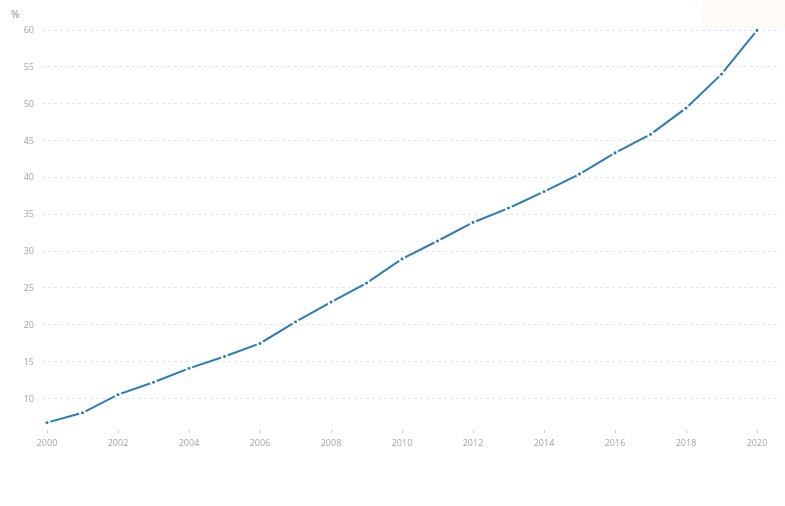
The history of eCommerce - part 3
Introduction
Welcome to part 3 of this series, so far we've looked at the earliest history of eCommerce from before the days of the commercial use of the internet, and then how some early adopters found eCommerce success even in the 90's. In todays post we look at the 00's, the decade when running an eCommerce store became widely available to the masses.
The 00's might be seen as a bit of sweetspot for eCommerce. The market was not yet crowded, but many people were now internet users. By the end of the 90's just 5% of people were online, but by 2010 this had risen to almost 30%. So the 2000's presented huge opportunities for retailers and this was the era when we saw eCommerce frameworks like Shopify, Magento and BigCommerce launch. We also saw already established companies like Facebook and Google launch advertising services, allowing retailers to reach audiences they couldn't before.


Percentage of internet users worldwide since 2000
At the end of the 90's and early 00's there was some trepidation and disappointment from retailers who had invested early in an online store but not really seen any significant return. However, they now found themselves ahead of the masses and in a position to capitalise on the huge influx of new internet users that would flood in over the next decade.
The possibilities of what could be achieved on the internet were now clear, and many people scrambled to capitalise on this. Those that had adopted early and already had an online store saw the benefits of that investment when the increasing number of shoppers began to spend more online. At the start of the 2000's the range of stores available was limited, so those who had a store were given the opportunity to take the lions share of sales in their sector.
But by 2009, the number of online stores had increased dramatically, and with that the competition. These changes drove higher demands from shoppers in terms of how your store performed and you increasingly needed to give people a reason to come to you instead of the competition. Frameworks like Magento and Shopify were developed specifically to give businesses a solid base on which to build and customise their online store, saving a huge amount of time and money compared to building a store from scratch.
New technologies
Early in the 2000's it was clear to all that there was significant money to be made on the internet, and that an online presence was quickly becoming a key requirement for every business, even those that didn't actually sell online. In response to this, many companies saw an opportunity to supply paid products to businesses who were, or soon would be selling, or wanting to advertise their services. So as well as eCommerce frameworks, we also saw Google launch Adwords, and Facebook launch Beacon which allowed targetted advertising.


Adwords
Google first launched Adwords in the year 2000, allowing store owners to show adverts to Google users based on the search terms they'd entered. Google found Adwords to be an instant success after trials in 1999, and one year in it had returned over $70 million. Over the new few years Google improved the filtering and display of ads, and in 2005 added the 'display network' as an additional way in which ads could be displayed on websites using the AdSense program.
Google has continued to expand and improve the functionality and possibilities offered by Adwords, and it remains and hugely popular advertising method today.


Shopify
In 2006 Shopify launched, and was created after finding existing eCommerce solutions to be lacking. It was developed to give a more modern and effective means to create an online store, providing store owners with a solid starting point to sell online.
In 2009 an API was added which opened up the possibility of customising and adding to the standard functionaltiy that was offered. With this came the app store where Shopify extensions could be listed and sold for any store owner to use.
Shopify continues to be very popular today, with countless thousands of active stores.


Facebook Beacon
Followed closely by controversy and significant concern around privacy, Facebook Beacon launched in 2007. This allowed Facebook to collect browsing data from users while on external websites, in order to show friends a users browsing activity and serve targetted ads. The requirement for a user to consent to their data being shared was soon demanded, and then added. Beacon soon attracted legal action, with the service then being shut down in 2009.


Magento
Magento was launched in 2008 and offered a level of customisation and flexibility not seen before. You were given full access to the codebase, along with effective means by which to customise or extend any base functionality. This unparralleled level of flexibility did however mean increased complexity requiring more development time and investment before launch. But if you had the budget to spend you would end up with exactly the store you wanted, whatever your business requirements - and this level of customisation remains today.
The release of Community Edition which was completely open source accelerated the take up of Magento and the framework rapidly became a hugely popular option for eCommerce store owners.
Magento, now owned by Adobe, and with the paid edition rebranded to Adobe Commerce, remains an extremely popular choice for store owners worldwide with countless thousands of active stores today.


BigCommerce
In 2009, BigCommerce launched, most directly competing with Shopify. It had a very similar offering with customisation possible through the API, but with a more complete offering of base functionality. BigCommerce is still a solid option for any eCommerce store today, although active store numbers aren't at the same level as Magento or Shopify.
Conclusion
If you were one of the relative few who had an online store in the early 2000's you had the opportunity to find significant success as customer numbers soared and those who weren't early adopters were playing catchup. By the end of the decade there were already huge numbers of internet users and if you were running an online store, you needed to take it to the next level if you wanted to stay ahead of the competition and attract more customers.
This was definitely a decade of opportunity, and if you could get to the stage where your store was established, and keep ahead of the compeition as technology and customer expectations continued to advance, you could find significant success. By the end of the decade eCommerce was fast becoming fiercely competitive requiring significant investment and a professional approach to running a store.
Thanks for reading part 3, in our final part next week we see eCommerce continue it's huge expansion, and how one new technology introduced a massive shift in how people used the internet - the smartphone.
See you next week!






